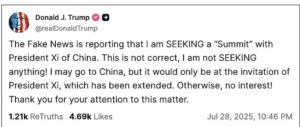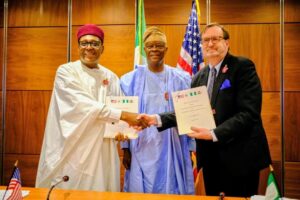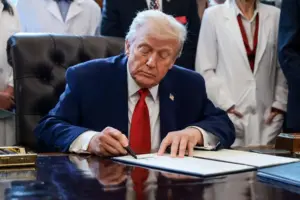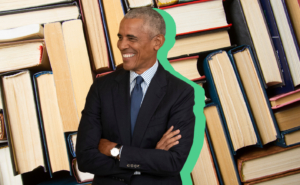U.S. President Donald Trump has denied reports that he is seeking a summit with Chinese President Xi Jinping amid escalating trade tensions between the two countries.
Though Trump revealed on his Truth Social platform that Xi has already extended a personal invitation for him to visit China.
He said “I may go to China, but it would only be at the invitation of President Xi, which has been extended. Otherwise, no interest!”

Aides to Trump and Xi have discussed a potential meeting between the leaders during a trip by the U.S. president to Asia later this year, sources previously reported.
We came over to take a look because it was raining really hard.
US negotiators are pushing to lock in a 90-day extension to the tariff pause, while also exploring deeper cooperation on issues ranging from fentanyl precursors to rare earth minerals, tech export controls, and China’s oil purchases from Russia and Iran.
Read Also
- FULL LIST: Nigeria, 23 Other Countries Affected By Donald Trump US Entry Restriction
- FULL LIST: US Orders Review Of Green Cards From 19 Countries After Washington Attack
- Ramaphosa Criticises Trump Over Decision to Exclude South African from 2026 G20 Summit
- "My Son Is A Big Fan Of Ronaldo", Trump Declares
A trip would be the first face-to-face encounter between the men since Trump’s second term in office, at a time when trade and security tensions between the two superpower rivals remain elevated.
While plans for a meeting have not been finalised, discussions on both sides of the Pacific have included a possible Trump stopover around the time of the Asia-Pacific Economic Cooperation summit in South Korea or talks on the sidelines of the October 30-November 1 event, the people said.
The third round of U.S.-China trade talks taking place in Stockholm this week may lay the groundwork ahead of a leaders’ summit in the autumn, analysts say.
A new flare-up of tariffs and export controls would likely impact any plans for a meeting with Xi.
US senators from both parties are preparing legislation this week targeting China on human rights, Taiwan, and tech surveillance, moves likely to provoke Beijing and raise the stakes of any talks.
At the heart of the negotiations is a decades-old standoff over structural imbalances.
Trump wants China to reduce overcapacity in key sectors like steel and EVs while increasing domestic consumption, a major sticking point since China’s economic model relies on export dominance.
Meanwhile, Beijing wants greater access to US markets and investment freedom including buying American aircraft, soybeans, and parts, in exchange for scaling back its own retaliatory tariffs.





